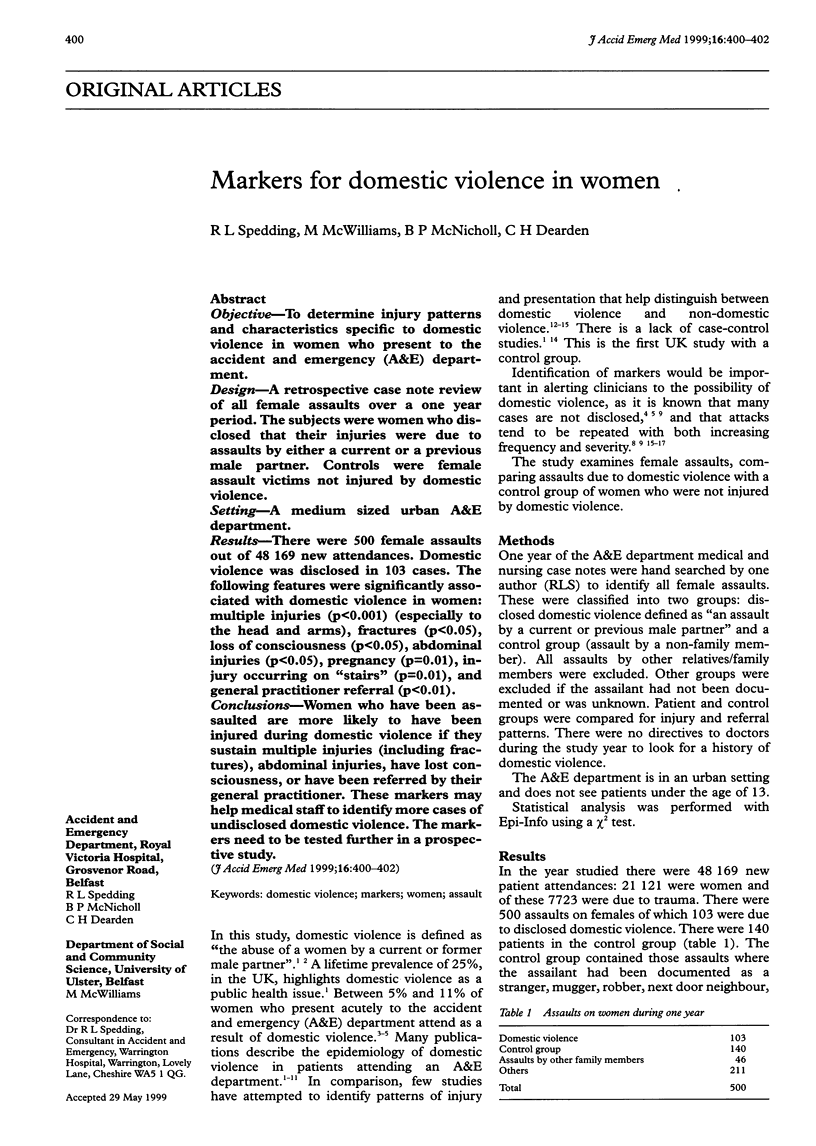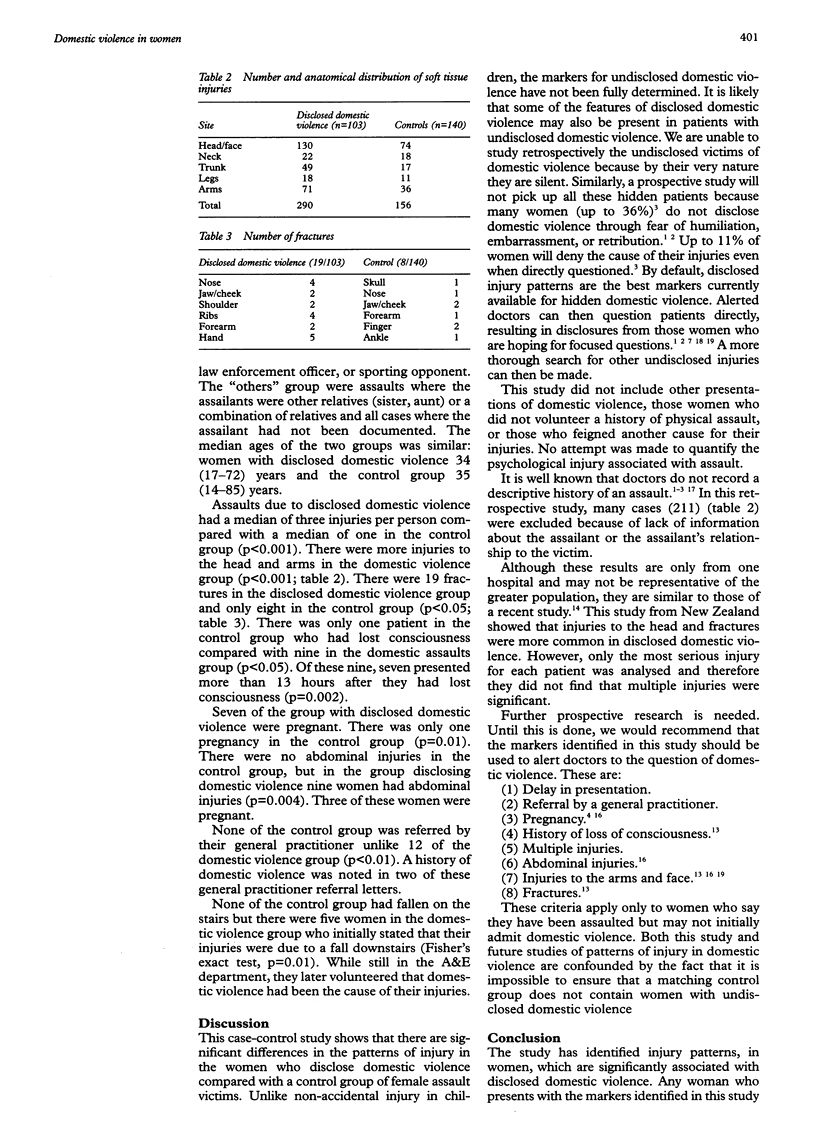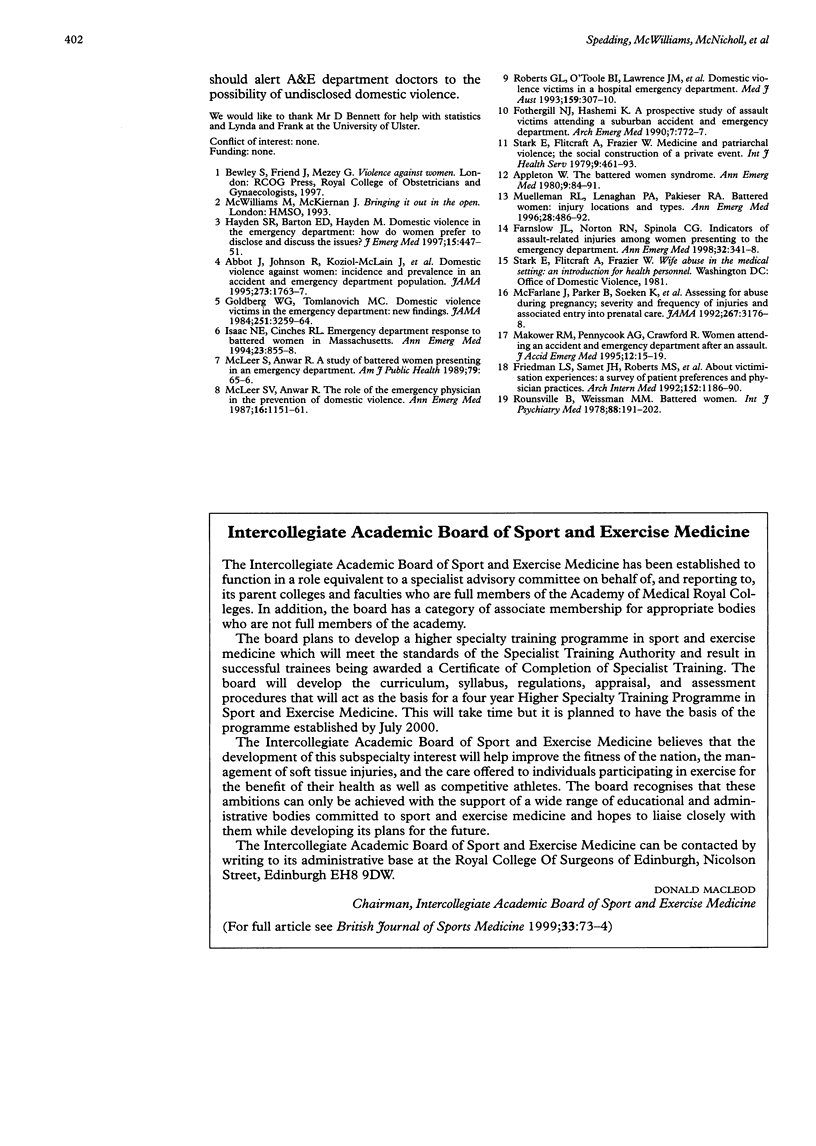Abstract
OBJECTIVE: To determine injury patterns and characteristics specific to domestic violence in women who present to the accident and emergency (A&E) department. DESIGN: A retrospective case note review of all female assaults over a one year period. The subjects were women who disclosed that their injuries were due to assaults by either a current or a previous male partner. Controls were female assault victims not injured by domestic violence. SETTING: A medium sized urban A&E department. RESULTS: There were 500 female assaults out of 48,169 new attendances. Domestic violence was disclosed in 103 cases. The following features were significantly associated with domestic violence in women: multiple injuries (p < 0.001) (especially to the head and arms), fractures (p < 0.05), loss of consciousness (p < 0.05), abdominal injuries (p < 0.05), pregnancy (p = 0.01), injury occurring on "stairs" (p = 0.01), and general practitioner referral (p < 0.01). CONCLUSIONS: Women who have been assaulted are more likely to have been injured during domestic violence if they sustain multiple injuries (including fractures), abdominal injuries, have lost consciousness, or have been referred by their general practitioner. These markers may help medical staff to identify more cases of undisclosed domestic violence. The markers need to be tested further in a prospective study.
Full text
PDF


Selected References
These references are in PubMed. This may not be the complete list of references from this article.
- Abbott J., Johnson R., Koziol-McLain J., Lowenstein S. R. Domestic violence against women. Incidence and prevalence in an emergency department population. JAMA. 1995 Jun 14;273(22):1763–1767. doi: 10.1001/jama.273.22.1763. [DOI] [PubMed] [Google Scholar]
- Appleton W. The battered woman syndrome. Ann Emerg Med. 1980 Feb;9(2):84–91. doi: 10.1016/s0196-0644(80)80336-2. [DOI] [PubMed] [Google Scholar]
- Brady H. R., Quigley C., Stafford F. J., Bresnihan B., Hourihane B., FitzGerald M. X. Popliteal cyst rupture and the pseudothrombophlebitis syndrome. Ann Emerg Med. 1987 Oct;16(10):1151–1154. doi: 10.1016/s0196-0644(87)80475-4. [DOI] [PubMed] [Google Scholar]
- Fanslow J. L., Norton R. N., Spinola C. G. Indicators of assault-related injuries among women presenting to the emergency department. Ann Emerg Med. 1998 Sep;32(3 Pt 1):341–348. doi: 10.1016/s0196-0644(98)70011-3. [DOI] [PubMed] [Google Scholar]
- Friedman L. S., Samet J. H., Roberts M. S., Hudlin M., Hans P. Inquiry about victimization experiences. A survey of patient preferences and physician practices. Arch Intern Med. 1992 Jun;152(6):1186–1190. doi: 10.1001/archinte.152.6.1186. [DOI] [PubMed] [Google Scholar]
- Goldberg W. G., Tomlanovich M. C. Domestic violence victims in the emergency department. New findings. JAMA. 1984 Jun 22;251(24):3259–3264. [PubMed] [Google Scholar]
- Hayden S. R., Barton E. D., Hayden M. Domestic violence in the emergency department: how do women prefer to disclose and discuss the issues? J Emerg Med. 1997 Jul-Aug;15(4):447–451. doi: 10.1016/s0736-4679(97)00070-x. [DOI] [PubMed] [Google Scholar]
- Isaac N. E., Sanchez R. L. Emergency department response to battered women in Massachusetts. Ann Emerg Med. 1994 Apr;23(4):855–858. doi: 10.1016/s0196-0644(94)70325-6. [DOI] [PubMed] [Google Scholar]
- Makower R. M., Pennycook A. G., Crawford R. Women attending an accident and emergency department after assaults. J Accid Emerg Med. 1995 Mar;12(1):15–19. doi: 10.1136/emj.12.1.15. [DOI] [PMC free article] [PubMed] [Google Scholar]
- McFarlane J., Parker B., Soeken K., Bullock L. Assessing for abuse during pregnancy. Severity and frequency of injuries and associated entry into prenatal care. JAMA. 1992 Jun 17;267(23):3176–3178. doi: 10.1001/jama.267.23.3176. [DOI] [PubMed] [Google Scholar]
- McLeer S. V., Anwar R. A study of battered women presenting in an emergency department. Am J Public Health. 1989 Jan;79(1):65–66. doi: 10.2105/ajph.79.1.65. [DOI] [PMC free article] [PubMed] [Google Scholar]
- Muelleman R. L., Lenaghan P. A., Pakieser R. A. Battered women: injury locations and types. Ann Emerg Med. 1996 Nov;28(5):486–492. doi: 10.1016/s0196-0644(96)70110-5. [DOI] [PubMed] [Google Scholar]
- Roberts G. L., O'Toole B. I., Lawrence J. M., Raphael B. Domestic violence victims in a hospital emergency department. Med J Aust. 1993 Sep 6;159(5):307–310. doi: 10.5694/j.1326-5377.1993.tb137866.x. [DOI] [PubMed] [Google Scholar]
- Stark E., Flitcraft A., Frazier W. Medicine and patriarchal violence: the social construction of a "private" event. Int J Health Serv. 1979;9(3):461–493. doi: 10.2190/KTLU-CCU7-BMNQ-V2KY. [DOI] [PubMed] [Google Scholar]


